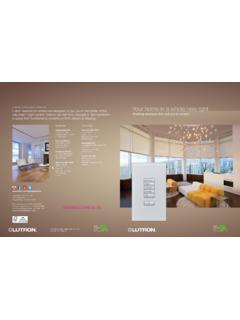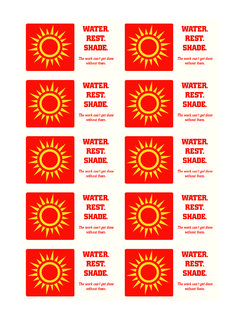Transcription of Eye Protection against Radiant Energy during …
1 FactSheetElectromagnetic Energy given off by an arc or flame can injure workers eyes and is commonly referred to as Radiant Energy or light radiation. For protec-tion from Radiant Energy , workers must use per-sonal protective equipment, such as safety glasses, goggles, welding helmets, or welding face shields. This equipment must have filter lenses with a shade number that provides the appropriate level of pro-tection. A shade number indicates the intensity of light radiation that is allowed to pass through a filter lens to one s eyes. Therefore, the higher the shade number, the darker the filter and the less light radiation that will pass through the lens. This requirement applies to the employees performing the work and to personnel observing the operation; for example, a fire watch or an assistant. The tables below list the minimum protective lens shade numbers for commonly used welding and cutting processes. When a worker wears eyewear equipped with filter lenses under a welding helmet, the shade number Eye Protection against Radiant Energy during Welding and Cutting in Shipyard Employmentof the lens in the helmet may be reduced.
2 The combined shade numbers of the lenses in the eyewear and helmet should equal the value shown in the tables below (see 29 CFR (a)(4) and ANSI :2005 Safety in Welding, Cutting, and Allied Processes). In addition, all protective eye and face devices must comply with ANSI , Practice for Occupational and Educational Eye and Face Protection (see 29 CFR (b)) for the selection, use and maintenance of these protective devices. When there is a potential for objects to fly in work-ers eyes and face, the protective device(s) selected must provide side Protection . Side Protection reduces the risks of hazards such as slag chips, grinding fragments and grinding bristles contacting a worker s eyes and face. Where such hazards exist, workers using a welding helmet with filter lenses would also need to wear glasses with side shields or 1: Filter Lenses for Protection during Shielded Metal Arc Welding OperationShielded Metal Arc Welding (SMAW)Electrode Size inch (mm)Less than 3/32 ( )3/32-5/32 ( )More than 5/32-1/4 ( )More than 1/4 ( )Arc Current(Amperes)Fewer than 6060-160 More than 160-250 More than 250-550 OSHA Minimum Protective Shade Number781011 ANSI & AWS Shade NumberRecommendations*- 10 12 14 Table 2: Filter Lenses for Gas Welding and Oxygen Cutting OperationsOperationGas WeldingOxygen CuttingPlate Thickness InchesUnder 1/81/4 to 1/2 Over 1/2 Under 11 to 6 Over 6 Plate Thickness mmUnder to 2525 to 150 Over 150 OSHA Minimum Protective Shade Number456345 ANSI & AWS Shade NumberRecommendations* 5 6 8 4 5 6 Table 3.
3 Filter Lenses for Protection during Other Welding and Cutting OperationsOperationGas Metal Arc Welding (GMAW) and Flux Cored Arc Welding (FCAW)Gas Tungsten Arc Welding (GTAW)Air Carbon Arc Cutting (CAC-A) (Light)Air Carbon Arc Cutting (CAC-A) (Heavy)Plasma Arc Welding (PAW)Plasma Arc Cutting (PAC)(Light)**Plasma Arc Cutting (PAC) (Medium)**Plasma Arc Cutting (PAC) (Heavy)**Torch Brazing (TB)Torch Soldering (TS)Carbon Arc Welding (CAW)Arc Current(Amperes)Fewer than 6060-160 More than 160-250 More than 250-500 Fewer than 5050-150 More than 150-500 Fewer than 500500-1000 Fewer than 2020-100 More than 100-400 More than 400-800 Fewer than 300300-400 More than 400-800 OSHA Minimum Protective Shade Number71010108810101168101189103214 ANSI & AWS Shade NumberRecommendations* - 11 12 1410 12 14 12 14 6-8 10 12 149 12 14 3 or 4 2 14* As a rule of thumb, start with a shade that is too dark to see the weld zone. Then, go to a lighter shade which gives a sufficient view of the weld zone without going below the minimum.
4 during oxygen gas welding or cutting where the torch produces a high yellow light, it is desirable to use a filter lens that absorbs the yellow or sodium line in the visible light (spectrum) of the operation. ** Values apply where the actual arc is clearly seen. Lighter filters may be used when the arc is hidden by the More Information: CPL 02-01-049 - 29 CFR Part 1915, Subpart I, Enforcement Guidance for Personal Protective Equipment in Shipyard Employment OSHA Publication 3151 (2003), Personal Protective EquipmentThis is one in a series of informational fact sheets highlighting OSHA programs, policies or standards. It does not impose any new compliance requirements. For a comprehensive list of compliance requirements of OSHA standards or regulations, refer to Title 29 of the Code of Federal Regulations. This information will be made available to sensory-impaired individuals upon request. The voice phone is (202) 693-1999; teletypewriter (TTY) number: (877) FS-3499 1/2012














